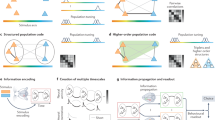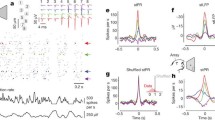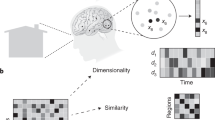Abstract
Researchers studying neural coding have speculated that populations of neurons would more effectively represent the stimulus if the neurons “cooperated:” by interacting through lateral connections, the neurons would process and represent information better than if they functioned independently. We apply our new theory of information processing to determine the fidelity limits of simple population structures to encode stimulus features. We focus on noncooperative populations, which have no lateral connections. We show that they always exhibit positively correlated responses and that as population size increases, they perfectly represent the information conveyed by their inputs regardless of the individual neuron's coding scheme. Cooperative populations, which do have lateral connections, can, depending on the nature of the connections, perform better or worse than their noncooperative counterparts. We further show that common notions of synergy fail to capture the level of cooperation and to reflect the information processing properties of populations.
Similar content being viewed by others
References
Abbott L, Dayan P (1999) The effect of correlated variability on the accuracy of a population code. Neural Comput. 11: 91-101.
Alonso J-M, Usrey W, Reid R (1996) Precisely correlated firing in cells of the lateral geniculate nucleus. Nature 383: 815-818.
Berger T (1971) Rate Distortion Theory. Prentice-Hall, Englewood Cliffs, NJ.
Bezzi M, Diamond M, Treves A (2001) Redundancy and synergy arising from correlations in large ensembles. arXiv:cond-mat 0012119.
Cover T, Thomas J (1991) Elements of Information Theory. Wiley, New York.
deCharms R, Merzenich M (1996) Primary cortical representation of sounds by the coordination of action-potential timing. Nature 381: 610-613.
Johnson D (2002) For top reasons why mutual information does not quantify neural information processing. In Computational Neuroscience' 02, Chicago, IL.
Johnson D, Gruner C, Baggerly K, Seshagiri C (2001) Informationtheoretic analysis of neural coding. J. Comp. Neurosci. 10: 47-69.
Johnson D, Gruner C, Glantz R (2000) Quantifying information transfer in spike generation. Neurocomputing 33: 1047-1054.
Johnson D, Ray W (2004) Optimal stimulus coding by neural populations using rate codes. J. Comp. Neurosci., to appear.
Kang K, Sompolinksy H (2001) Mutual information of population codes and distance measures in probability space. Phys. Rev. Letters 86: 4958-4961.
Kilgard M, Merzenich M (1999) Distributed representation of spectral and temporal information in rat primary auditory cortex. Hearing Res. 134: 16-28.
Kolmogorov A (1956) On the Shannon theory of information transmission in the case of continuous signals. IRE Trans. Info. Th. 3: 102-108.
Nirenberg S, Carcieri S, Jacobs A, Latham P (2001) Retinal ganglion cells act largely as independent encoders. Nature 411: 698-701.
Reich D, Mechler F, Victor J (2001) Independent and redundant information in nearby cortical neurons. Science 294: 2566-2568.
Rozell C, Johnson D, Glantz R (2002) Information processing during transient responses in the crayfish visual system. In Computational Neuroscience'02 Chicago, IL.
Shamir M, Sompolinsky H (2001) Correlation codes in neuronal populations. In T. Dietterich, S. Becker, and Z. Ghahramani, eds., Advances in Neural Information Processing Systems. MIT Press, Cambridge, MA, Vol. 14, pp. 277-284.
Shannon C (1948) A mathematical theory of communication. Bell System Tech. J. 379-423, 623-656.
Sinanovi´c S, Johnson D (2004) Toward a theory of information processing, in preparation.
Strong S, Koberle R, de Ruyter van Steveninck R, Bialek W (1998) Entropy and information in neural spike trains. Phys. Rev. Letters 80: 197-200.
Tishby N, Pereira F, Bialek W (1999) The information bottleneck method. In Proc. 37th Allerton Conference on Communication, Control and Computing, pp. 368-377.
Warland D, Reinagel P, Meister M (1997) Decoding visual information from a population of retinal ganglion cells. J. Neurophysiol. 78: 2336-2350.
Wilke S, Eurich C (2002) Representational accuracy of stochastic neural populations. Neural Comput. 14: 155-189.
Author information
Authors and Affiliations
Rights and permissions
About this article
Cite this article
Johnson, D.H. Neural Population Structures and Consequences for Neural Coding. J Comput Neurosci 16, 69–80 (2004). https://doi.org/10.1023/B:JCNS.0000004842.04535.7c
Issue Date:
DOI: https://doi.org/10.1023/B:JCNS.0000004842.04535.7c




